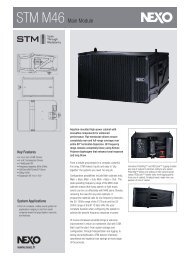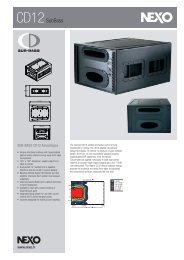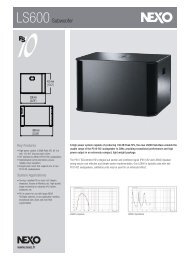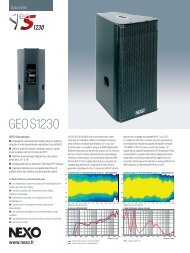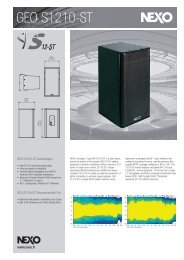Inverse Distance Weighting for Extrapolating Balloon ... - Nexo
Inverse Distance Weighting for Extrapolating Balloon ... - Nexo
Inverse Distance Weighting for Extrapolating Balloon ... - Nexo
Create successful ePaper yourself
Turn your PDF publications into a flip-book with our unique Google optimized e-Paper software.
<strong>Inverse</strong> <strong>Distance</strong> <strong>Weighting</strong><br />
<strong>for</strong> <strong>Extrapolating</strong> <strong>Balloon</strong>-Directivity-Plots<br />
Joerg Panzer<br />
NEXO<br />
joerg.panzer@nexo.fr<br />
Daniele Ponteggia<br />
Audiomatica<br />
dp@audiomatica.com<br />
Presented at the AES 131th Convention, New York, 2011<br />
Abstract<br />
This paper investigates an extrapolation <strong>for</strong> missing directivity-data in connection with <strong>Balloon</strong>-Plots. Such<br />
plots display the spherical directivity-pattern of radiators and receivers in <strong>for</strong>m of contoured sound pressure<br />
levels. Normally the directivity-data are distributed evenly so that at each point of the display-sphere there<br />
would be sufficient data-points. However, there are circumstances where we want to display data that are<br />
not evenly distributed. For example, there might be only available the horizontal and vertical scans. The<br />
proposed <strong>Inverse</strong> <strong>Distance</strong> <strong>Weighting</strong> method is a means to extrapolate into these gaps. This paper explains<br />
this method and demonstrates some examples.<br />
1 INTRODUCTION<br />
The radiation characteristic of electro-acoustic devices<br />
can be measured or simulated by sampling over a sphere<br />
of a given radius around the device under test.<br />
Usually the sampling is carried out in spherical coordinates<br />
on a regular angular grid, as described in [1].<br />
Once data are collected, the data-set is graphically represented<br />
with the help of so called balloon-plots. These<br />
plots are in the <strong>for</strong>m of contour plots over a spherical surface<br />
or as surfaces in spherical coordinates where the radius<br />
is proportional to the gain of the device along the<br />
pointed direction.<br />
It may happen that, due to the complexity of measurement<br />
infrastructure or non-regular sampling over the<br />
spherical surfaces, that there is need to extrapolate data<br />
from a reduced or incomplete set of measurement points.<br />
On the sphere, there<strong>for</strong>e, there might be gaps large<br />
enough that we do not know the values, hence the usage<br />
of the term “extrapolate” in the sense of [2]:<br />
“In mathematics, extrapolation is the<br />
process of constructing new data points. It<br />
is similar to the process of interpolation,<br />
which constructs new points between known<br />
points, but the results of extrapolations are<br />
often less meaningful, and are subject to<br />
greater uncertainty. It may also mean extension<br />
of a method, assuming similar methods<br />
will be applicable. ...”<br />
Beside the gaps, dense data might be available. For<br />
example a common case is the extrapolation from measurements<br />
done on horizontal and vertical scan-lines<br />
only.<br />
Because on the sphere any point is naturally “surrounded”<br />
by other points, we could per<strong>for</strong>m any of the<br />
interpolation-schemes in order to obtain an intermediate<br />
value [3][4]. However, in this paper, we would like to<br />
draw attention to a particular scheme, which is straight<strong>for</strong>ward<br />
to apply and which can be used <strong>for</strong> interpolation<br />
as well as <strong>for</strong> extrapolation problems. It seems to cope<br />
well also with anisotropic distribution of points. The approach<br />
is based on [5]. We have adapted it <strong>for</strong> spherical<br />
coordinates and we call it <strong>Inverse</strong> <strong>Distance</strong> <strong>Weighting</strong><br />
(IDW) as described in section 2.1.2.<br />
In the first part of this paper we investigate the extrapolation<br />
applied to a canonical test-function on an<br />
anisotropic grid. For comparisons two approaches are<br />
shown: 1) Decomposition with Spherical Harmonics.<br />
2) The <strong>Inverse</strong> <strong>Distance</strong> <strong>Weighting</strong>. The first part also<br />
explains the <strong>Inverse</strong> <strong>Distance</strong> <strong>Weighting</strong>.<br />
The second part demonstrates the application of the<br />
<strong>Inverse</strong> <strong>Distance</strong> <strong>Weighting</strong> method to a set of measurement<br />
curves.<br />
2 TEST FUNCTION<br />
The “SincSinc”-function features the directivity of a rectangular<br />
piston in an infinite baffle [6].<br />
( ) ( )<br />
Lx<br />
D (k x , k y ) = sinc<br />
2 · k Ly<br />
x · sinc<br />
2 · k y<br />
1
Panzer, Ponteggia<br />
IDW <strong>for</strong> Extapolating <strong>Balloon</strong>-Plots<br />
Figure 1: Test-function at 5 kHz mapped on a mesh of regular polar-scan-lines with an angular resolution of 5 deg. To the<br />
right is shown the projection of the levels along the ring at 45 deg onto a polar-plot.<br />
Figure 2: Spherical grids.<br />
with k x = k·cos (ϕ)·sin (θ), k y = k·sin (ϕ)·sin (θ),<br />
k = ω/c, ω is angular frequency, c is speed of sound, ϕ<br />
is the azimuthal and θ is polar angle in spherical coordinates.<br />
L x and L y are the dimensions of the rectangle.<br />
For all examples the test-function is used with following<br />
values: L x =0.2 m, L y =0.1 m, c= 343 m/s. A frequency<br />
f = 5 kHz is used.<br />
The highest angular resolution of any balloon-mesh<br />
is 5 deg. All contours display a range of 50 dB in steps of<br />
3 dB.<br />
The SincSinc-function turns out to be a good testfunction<br />
<strong>for</strong> checking extrapolation schemes <strong>for</strong> radiation<br />
problems, because it features typical radiation patterns including<br />
marked interferences (figure 1).<br />
Note, the data-set has been rotated by 2.5 deg about<br />
the x-, y- and z-axis in order to provide a simple regularization<br />
<strong>for</strong> following analysis. With the help of the slight<br />
shift we make sure that target points do not coincide with<br />
source points and thus true interpolation is always per<strong>for</strong>med.<br />
2.1 Extrapolation Example<br />
In the following we want to demonstrate the basic problem<br />
by constructing an example, which would makes necessary<br />
extrapolation. The idea is to use the SincSincfunction<br />
as an example and to calculate values on a non<br />
regular grid on the sphere.<br />
An anisotropic grid could be constructed in the following<br />
way. To the left of figure 2 we have the regular<br />
grid with 5 deg angular resolution. The mesh in the center<br />
is anisotropic and provides points at 5 deg resolution<br />
in polar direction and 30 deg resolution in azimuthal direction,<br />
hence there are wide gaps circumferential. The<br />
right plot, finally, pictures the extreme case, where there<br />
is a dense distribution of points on vertical and horizontal<br />
scan-lines but naught in between.<br />
The idea is to investigate how two selected interpolation<br />
schemes cope with the rarefied distributions. Because<br />
we know how the function should appear, if sampled<br />
properly, we can compare the pictures of the balloon<br />
plot and a selected mapping of a polar-plot (along<br />
the dark arc) to the original plots as shown in figure 1.<br />
2.1.1 Spherical Harmonics<br />
Intuitively a promising interpolation scheme should be<br />
holistic, which means it would take into account all available<br />
points in order to magically fill the gaps. Is there a<br />
function, which by nature behaves like a “radiator”? If<br />
2
Panzer, Ponteggia<br />
IDW <strong>for</strong> Extapolating <strong>Balloon</strong>-Plots<br />
Figure 3: Extrapolation with Spherical Harmonics.<br />
we take many of such functions and weight each of these<br />
in such a way that the sum-total satisfies known-values on<br />
the sphere, then it should also give reasonable values <strong>for</strong><br />
the unknown territory. These functions are called Spherical<br />
Harmonics or Multipole Expansion [6].<br />
Spherical Harmonics is the natural mode-set of a<br />
sphere. In principal any regular distribution of values on<br />
a sphere can be assembled from a spectrum of Spherical<br />
Harmonics, similar to Fourier and polynomial interpolation<br />
in Cartesian coordinates.<br />
The text-book implementation of modal decomposition<br />
in Spherical Harmonics works fine as long as each<br />
mode gets sufficient data-points to adjust itself. This is<br />
one of the reasons why we have added a little rotation to<br />
3
Panzer, Ponteggia<br />
IDW <strong>for</strong> Extapolating <strong>Balloon</strong>-Plots<br />
Figure 4: Extrapolation with IDW.<br />
the original data-set, in order to avoid nodal lines of the<br />
modes to fall on peculiar scan-lines of the data-set.<br />
For 5/5 deg: The first row of the picture-table 3 is<br />
a decomposition with 20·20-modes on a regular 5 deg<br />
mesh. The decomposition compares well to the original.<br />
For 5/30 deg: The second row shows the decomposition<br />
of an anisotropic grid. The algorithm turned out to<br />
be stable only up to 6·6 modes. Compared to the original,<br />
the balloon-contours and the polar-curve are quite different.<br />
However, <strong>for</strong> a “reach into the unknown” the result<br />
may be considered not too bad. First, the overall pattern<br />
is reproduced in level. Second, the Spherical Harmonics<br />
yields typical interference patterns of a radiator, which<br />
other general extrapolation schemes may not be able to<br />
4
Panzer, Ponteggia<br />
IDW <strong>for</strong> Extapolating <strong>Balloon</strong>-Plots<br />
produce.<br />
For 5/90 deg: The modal decomposition algorithm<br />
turned out to be unstable <strong>for</strong> any mode beyond 2·2<br />
(dipoles). However, the result is an omni-directional<br />
mean-value.<br />
2.1.2 <strong>Inverse</strong> <strong>Distance</strong> <strong>Weighting</strong><br />
The <strong>Inverse</strong> <strong>Distance</strong> <strong>Weighting</strong> method (IDW) is a sort<br />
of mean-value <strong>for</strong>ming approach <strong>for</strong> calculating a value<br />
at any point on the sphere by taking into account the contribution<br />
of all original points.<br />
f (P ) =<br />
∑<br />
i<br />
d −u<br />
i<br />
∑<br />
i<br />
d −u<br />
i<br />
f (P ) = z i | di→0<br />
· z i<br />
with f(P ) a value anywhere on the sphere at point P .<br />
z i is a value from the original data-set at point D i . The<br />
function d i is the surface-distance on the sphere between<br />
vectors P and D i :<br />
d i = arccos (P · D i )<br />
For <strong>Inverse</strong> <strong>Distance</strong> <strong>Weighting</strong> the factor u ≥ 1.<br />
Typically u = 2...5. For the above examples u = 3<br />
is used. For interesting details see [5]. If d i = 0 then<br />
we substitute the original value z i at point D i . It turned<br />
out that the algorithm works better if only points from a<br />
hemisphere are used with:<br />
P · D i > 0<br />
Thus, each data-point contributes according to the inverse<br />
of its distance. Data-points, which are close to P<br />
provide a strong influence, and data-points further away<br />
contribute less. Naturally, the IDW provides a very stable<br />
extrapolation as long as u ≥ 1. However, as the weightfunction<br />
does not provide oscillations there are no additional<br />
interferences produced, which in turn yields the resulting<br />
values of the extrapolation often to be too optimistic.<br />
Or, in other words, the values further away from<br />
the original data-set turn out to be too high compared to<br />
the regular sampled version.<br />
Figure 4 provides levels as contours on the balloon<br />
surface and polar-plots of the <strong>Inverse</strong> <strong>Distance</strong> <strong>Weighting</strong><br />
method. As in the previous example the original dataset<br />
is the SincSinc-function (figure 1) rotated by 2.5 deg<br />
about x-, y- and z-axis. The rotation is applied in order<br />
to trigger the IDW <strong>for</strong> all cases. All extrapolations are<br />
per<strong>for</strong>med with u = 3.<br />
For 5/5 deg: The first row shows the application of<br />
the IDW on the regular grid. Because of the rotation by<br />
2.5 deg the IDW provides interpolated values. The results<br />
compare well to the pictures of the original function.<br />
Some spatial smoothing is present.<br />
For 5/30 deg: The second row shows the result of<br />
the IDW <strong>for</strong> original points distributed on an anisotropic<br />
grid. The pattern of the contours is different compared<br />
to the original balloon, however, the main features are<br />
maintained. The response obviously appears strongly<br />
smoothed as can be seen also in the polar-plot.<br />
For 5/90 deg: The last row displays the extreme<br />
case, where the original function is provided only on two<br />
scan-lines. Interestingly the balloon contours still display<br />
some of the main features of the directivity of a rectangular<br />
piston. However, as already stated, the level in the<br />
extrapolated regions turn out to be too high. This is understandable<br />
because the original function provides interference<br />
whereas the IDW does not.<br />
Compared to the Spherical Harmonic approach the<br />
IDW seems more stable and easy to adjust. During experiments<br />
the Spherical Harmonic approach often failed,<br />
needed special regularization and asked <strong>for</strong> a careful adjustment<br />
of the number of modes. The IDW on the other<br />
hand always yields a meaningful result, however, often<br />
blurred and too optimistic.<br />
3 MEASUREMENT<br />
The measurement of a loudspeaker 3D directivity, as described<br />
in [1], requires the loudspeaker impulse response<br />
to be sampled with a 5 degree resolution “equi-angular”<br />
spherical pattern. This means a total of 2664 measurement<br />
points [7].<br />
Among the different approaches to acquire the 3D<br />
measurement set we may: use multiple microphones,<br />
move one or more microphones around the loudspeaker,<br />
use a single fixed microphone coupled with a mechanical<br />
system to orient the loudspeaker towards a given direction<br />
or any mix of the above. It is outside the scope of<br />
this paper to enter into the details of 3D measurements.<br />
We would like to point out here the complexity of such<br />
kind of setup, both in terms of needed hardware and time.<br />
A simpler and more cost-effective alternative is to<br />
sample the sphere over only a few scan-lines. Using a<br />
single fixed microphone and a single turntable (or equivalent)<br />
it is easily possible to sample the loudspeaker response<br />
over the horizontal and vertical scan-lines. This<br />
can be done by placing the loudspeaker in vertical and<br />
horizontal position on the turntable, the rotation of the<br />
turntable corresponds to an apparent rotation of the microphone<br />
around the loudspeaker.<br />
In this case the full balloon response has to be extrapolated<br />
from the available data. We will compare here the<br />
results of 5 degrees full-balloon measurements with an<br />
extrapolation made with the IDW method.<br />
Be<strong>for</strong>e showing the results of real world examples,<br />
we need to introduce another graphical representation of<br />
the 3D directivity in the <strong>for</strong>m of a color-map as rectangular<br />
projection of the sphere: the two spherical coordinates<br />
angles ϕ and θ are projected on the x- and y- axes, while<br />
the sound pressure level is represented by a color shade<br />
(see figure 5). Despite the distortion introduced by such<br />
projection, this allows <strong>for</strong> a simple representation of the<br />
5
Panzer, Ponteggia<br />
IDW <strong>for</strong> Extapolating <strong>Balloon</strong>-Plots<br />
Figure 5: Color-map plot: directivity balloon is projected on a plane.<br />
Figure 6: Driver on exponential horn balloon at 8 kHz: (left-top) 5 degree measured, (right-top) IDW extrapolation,<br />
(bottom) absolute error.<br />
difference between 5 degrees 3D balloon measurement<br />
and data extrapolation made with the IDW method.<br />
We will report here two different case studies: a<br />
1 inch compression driver on a 90x60 exponential horn,<br />
and a small bookshelf 2-way sealed loudspeaker box.<br />
Throughout these examples u = 3 has been used <strong>for</strong> the<br />
IDW extrapolation and data has been smoothed by third<br />
octave bands.<br />
3.1 Compression driver on exponential<br />
horn<br />
The driver-horn assembly has been measured in 3D using<br />
two computer controlled turntables, with an angular<br />
resolution of 5 degrees. Since the source has a symmetry<br />
along the vertical and horizontal planes, only a quarter of<br />
a sphere has been sampled and data has been then mirrored.<br />
Figure 6 (left-top) shows the measured balloon plot<br />
(in this plot the surface is distorted in such a way that the<br />
radius of the sphere is proportional to the sound pressure<br />
level) of the driver at 8 kHz frequency band, where the<br />
effect of the rectangular aperture is clearly visible. In the<br />
same figure 6 (right-top) the balloon extrapolated from<br />
horizontal and vertical scan-lines using the IDW method<br />
is shown.<br />
The absolute error in dB between measured and data<br />
extrapolated is shown in the bottom row of figure 6 as a<br />
color-map plot.<br />
While the absolute error is not small, the overall balloon<br />
shape is not affected, as previously found with the<br />
sincsinc test function.<br />
3.2 Small 2-way loudspeaker box<br />
The 2-way box has been measured in 3D using the same<br />
setup as above. Due to the horizontal symmetry only half<br />
sphere has been sampled and then data mirrored.<br />
This loudspeaker exhibits an interference pattern between<br />
the two drivers at the crossover frequency. The<br />
interference can be seen in the 3.15 kHz one third frequency<br />
band measured balloon (figure 8 (left-top)).<br />
Figure 8 (mid-top) illustrates the balloon extrapolated<br />
from horizontal and vertical scan-lines using the<br />
IDW method. A color-map plot of the absolute error<br />
of the IDW extrapolation using the above scan lines is<br />
6
Panzer, Ponteggia<br />
IDW <strong>for</strong> Extapolating <strong>Balloon</strong>-Plots<br />
Figure 7: Horizontal, Vertical and Equatorial Scan-Lines.<br />
Figure 8: 2-Way loudspeaker at 3.15 kHz: (left-top) 5 degree measured, (mid-top) IDW extrapolation H+V, (right-top)<br />
IDW extrapolation H+V+E, (left-bottom) absolute error H+V, (right-bottom) absolute error H+V+E.<br />
in figure 8 (left-bottom). Here again, while the balloon<br />
presents quite a complex behavior featuring multiple<br />
side-lobes, the overall shape is kept and side-lobes<br />
are present, albeit attenuated.<br />
The error of the IDW extrapolation can be reduced using<br />
more scan-lines. We will propose here a very simple<br />
setup to collect an additional scan-line that, in an analogy<br />
with earth science, we call “equatorial” (figure 7).<br />
The proposed setup uses a single turntable and a single<br />
fixed microphone, as in the case of horizontal and vertical<br />
scan-lines. In order to collect the equatorial scan-line, the<br />
loudspeaker under test has to be placed on the turntable<br />
facing up (pointing towards the ceiling).<br />
The balloon plot of the data extrapolated with IDW<br />
method using horizontal, vertical and equatorial scan-line<br />
is presented in figure 8 (right-top) and the error is shown<br />
as color-map plot in the same figure (right-bottom). The<br />
presence of the “equatorial” data helps to reduce the error,<br />
while the required additional measurement ef<strong>for</strong>t is<br />
minimum.<br />
4 CONCLUSIONS<br />
This paper reports on the investigation of the application<br />
of the <strong>Inverse</strong> <strong>Distance</strong> <strong>Weighting</strong> method <strong>for</strong> extrapolating<br />
incomplete 3D directivity data.<br />
The IDW is not a substitute <strong>for</strong> the complete data-set<br />
as can clearly been seen by the investigation of the canonical<br />
SincSinc function and by the error-maps of measurements<br />
done. However, the IDW can provide rough estimates<br />
<strong>for</strong> the unknown areas even under the extreme case,<br />
where only a horizontal and vertical scan-line is available.<br />
In any case the IDW provides bounded results and is easy<br />
to apply.<br />
As most measurement setups go along scan-lines it<br />
seems beneficial in this context to measure the device un-<br />
7
Panzer, Ponteggia<br />
IDW <strong>for</strong> Extapolating <strong>Balloon</strong>-Plots<br />
der test also equatorial.<br />
Future research will investigate refinements of the<br />
IDW and will look into other possibilities of extrapolating<br />
the balloon-plot.<br />
5 AKNOWLEDGEMENTS<br />
The authors sincerely acknowledge the companies<br />
NEXO S.A. (www.nexo.fr) and Audiomatica (www.<br />
audiomatica.com) <strong>for</strong> support of this paper.<br />
References<br />
[1] AES Standard, “Sound source modeling - loudspeaker<br />
polar radiation measurements”, AES56-<br />
2008.<br />
[2] Wikipedia, “Extrapolation”, https:<br />
//secure.wikimedia.org/wikipedia/<br />
en/w/index.php?title=<br />
Extrapolation&oldid=438224623 (accessed<br />
August 8, 2011).<br />
[3] Renka, R., “Interpolation of data on the surface of<br />
a sphere and triangulation and interpolation at arbitrary<br />
distributed points in the plane”, ACM Trans.<br />
Math. Softw 10, 4 (Dec 1984).<br />
[4] Buss, S., Fillmore, J., “Spherical averages and applications<br />
to spherical splines and interpolation”,<br />
ACM Trans. Graph., 20, 2 (April 2001).<br />
[5] Shepard, D., “A two-dimensional interpolation<br />
function <strong>for</strong> irregular-spaced data”, ACM Proc. Nat.<br />
Conf. 1968.<br />
[6] Williams, E., “Fourier acoustics”, Academic Press,<br />
1999.<br />
[7] Ponteggia, D., “AN-002, Automated <strong>Balloon</strong><br />
Measurements Using CLIO 10”, http:<br />
//www.audiomatica.com/download/<br />
appnote_002.pdf, Audiomatica, 2009<br />
8






